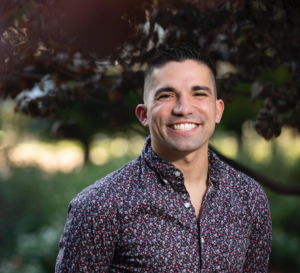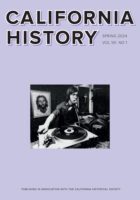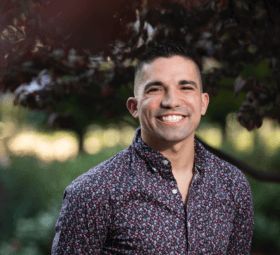Born-Again Boogie: A Q&A with Eric Gonzaba

Congratulations to Eric Gonzaba whose article, “Born-Again Boogie: Christian Nightclub Experiments in California, 1970–1990,” published in California History's Spring 2024 issue (101.1), has been awarded the Western History Association's 2025 Arrington-Prucha Prize, which recognizes the best article on American western religious history. The article examines the culture of California Christian nightclubs opened by evangelical entrepreneurs in the 1970s and ’80s—part of an effort to reclaim secular spaces and transform them into Christian copies of typical nightlife sites like bars and dance clubs—and explores the reasons for their failure to become a significant part of American nightlife. We asked Eric to tell us more about the research that led to his award-winning article.
What first sparked your interest in writing about Christian nightclubs?
To be honest, I had never heard of Christian nightclubs before. I stumbled across them completely by accident. At the time, I was deep into research for my dissertation on gay male nightlife since Stonewall. That particular day, I was hunting for photographs of some of the gay spaces I was writing about. But as your readers probably know, research is rarely neat and tidy; you often end up finding more of what you weren’t looking for than what you set out to find.
In the UCLA archives, I came across a photograph (which appears in print in the article) of a young couple playing pool. Before I even read the caption, my eye went straight to the menu sign behind them: hot dogs, strawberry shortcake, and, weirdly, “Spiritual Food” listed as free. When I learned the photo was from a 1971 LA Times article on Christian nightclubs, I was honestly shocked. In my mind, evangelical Christians represented one of the most oppositional cultures to the community I was studying, gay men. To realize that both groups were developing their own nightlife scenes around the same time really piqued my interest.
But I didn’t have time to chase this new lead. So, I followed a piece of advice from one of my dissertation committee members, Zach Schrag at George Mason: whenever you stumble on a new idea in the archives, file it away in a dedicated folder on your computer and come back to it later. It took a few years, but I finally returned to the idea after moving to California in 2019 to start my professorship at Cal State Fullerton.
If someone walked into one of these clubs in the 1970s, what would they have seen, heard, or even ordered at the bar?
My article examines about eight Christian nightclubs that operated in California between 1970 and 1990, from the Bay Area to Fresno, all the way down to Los Angeles and Orange County. Despite popping up across the state, many of these clubs were remarkably similar in character. Evangelical nightlife entrepreneurs wanted to create a Christian version of bars and clubs that felt distinct from church-sanctioned gatherings, so they closely imitated the secular nightclub trends of their day. For example, by the late 1970s, as disco fever swept the country, they were investing heavily in sound systems and dance floors, aiming to draw in young people to dance and have fun. But there were also key features that made Christian nightclubs different from their secular counterparts. Smoking was banned in nearly all of them. Walls often featured Christian imagery like crosses, portraits of Christ, or Bible passages painted like slogans. Even the bathrooms were distinctive, labeled not “Men” and “Women” but “Brothers” and “Sisters.” The most obvious difference, though, was that Christian nightclubs did not serve alcohol. That’s not to say they skipped the bar altogether; if you’re trying to mimic a nightclub, you have to have a bar, right? Most of these clubs installed mahogany bars that sold not just sodas and teas but also specialty zero-proof cocktails with playful religious names: “Samson’s Delight,” “Carpenter’s Quencher,” and my personal favorite, a milk-and-honey concoction called the “Promised Land.”
You think of yourself as a historian of American nightlife. Why do you think nightlife is such a revealing window into American culture?
Nightlife can tell us a lot about Americans precisely because so many people dismiss it as trivial. We often assume it’s just about folks going out to have a good time, but what people do at night and how they think about nightlife reveals a great deal about what they value and how they see the world. Take these Christian nightclub entrepreneurs. It’s tempting to file them under a sidebar of a Ripley’s Believe It or Not book, but I think their story tells us something deeper about the rise of evangelicalism in the late 20th century US. Their desire to mimic secular nightlife is striking, especially since bars and clubs are so often linked to vice and sin that we might expect Christians to avoid them altogether. These clubs, I argue, give us insight into evangelicals’ hope that their faith wouldn’t be confined to Sunday morning pews but could extend into what they hoped to make as a godly world beyond church walls. They also believed that nightclubs offered another avenue to spread their faith to people who would never set foot inside an evangelical church.
For those who haven’t read the article yet, what was the most unexpected, fascinating, or even funny detail you came across while researching these clubs?
One of my favorite things I like to mention is that some Christian nightclubs enforced strict dress codes to keep their spaces modest and “classy.” They actually banned tank tops, shorts, and even sandals. Sandals!? Which means, technically, Jesus Christ himself wouldn’t have been allowed past the bouncer at many of these Christian nightclubs.
Do you think the story of Christian nightclubs ended in the 1980s, or does it still have relevance today?
I’ve never been a big believer in the idea that history simply repeats itself, but as I was finishing this project, I started hearing about new Christian nightclubs popping up across the country, in places like Charlotte, Nashville, and even North Hollywood, and many of them are going viral on TikTok. The videos show massive crowds of young people listening to Christian hip hop and rap, but under strict rules: no smoking, no drinking, and even no twerking. It’s fascinating to see how Christians are still trying to adapt to modern nightlife culture. I just wish these new entrepreneurs knew there were Christian club owners who came before them confronting many similar issues. Maybe they’d find some lessons in my article.

We invite you to read Eric Gonzaba's award-winning article, “Born-Again Boogie: Christian Nightclub Experiments in California, 1970–1990,” for free online for a limited time.
Print copies of California History's Spring 2024 issue (issue 101.1), in which the article appears, as well as other individual issues of California History, can be purchased on the journal’s site.
For ongoing access to California History, please ask your librarian to subscribe and/or purchase an individual subscription.
